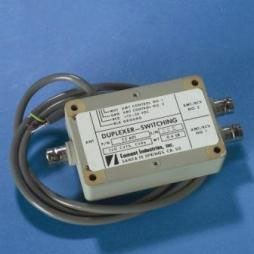Tom,
Heaven forbid that you should transmit on one radio and have the other
set to the same frequency - does overload ring a bell? If you have done
this, perhaps the radios are damaged.
First, most antenna discussions warn the user that antennas placed close
together will suck the energy out of both receptions and transmissions. It
doesn't matter whether they are both active or even covering the same frequency
although there may be an issue with harmonics. LNC2's are difficult to
satisfy the usual requirement that the min distance betwixt antennas is 3 or 4
feet because these aircraft are so small. If you have two comm
antennas in the vertical stab or curving in the tail cone (arrrgghhh!), well,
you shouldn't be surprised with the result. Perhaps you should consider
mount a comm bent whisker on the bottom.
Second, is it far more common to use a single comm antenna with a switcher
that shuts off the connection to the other radio when one is
transmitting.
|
COMANT DUPLEXER
(CI-601) |
 |
Frequency • 118-136
MHz
Dual communication/single antenna duplexer designed
to provide operation between two transceivers and one antenna. In
the de-energize mode, the diplexer acts as a 3 dB coupler with the
output ports isolated by 20dB. Control voltage actuated by the
microphone circuit switches the antenna to transmitter No. 1 or
transmitter No. 2. | |
|
COMANT
DUPLEXER
(CI-601) |
|

|
Frequency
• 118-136 MHz
Dual
communication/single antenna duplexer designed to provide operation
between two transceivers and one antenna. In the de-energize mode,
the diplexer acts as a 3 dB coupler with the output ports isolated
by 20dB. Control voltage actuated by the microphone circuit switches
the antenna to transmitter No. 1 or transmitter No.
2. |
Third, carbon can affect antennas. Perhaps your
problem is merely that the antennae are shielded if they are sitting
between the carbon areas you
describe. |
|
(CI-601) |
 |
Frequency • 118-136
MHz
Dual communication/single antenna duplexer designed
to provide operation between two transceivers and one antenna. In
the de-energize mode, the diplexer acts as a 3 dB coupler with the
output ports isolated by 20dB. Control voltage actuated by the
microphone circuit switches the antenna to transmitter No. 1 or
transmitter No. 2. | |
|
(CI-601) |
 |
Frequency • 118-136
MHz
Dual communication/single antenna duplexer designed
to provide operation between two transceivers and one antenna. In
the de-energize mode, the diplexer acts as a 3 dB coupler with the
output ports isolated by 20dB. Control voltage actuated by the
microphone circuit switches the antenna to transmitter No. 1 or
transmitter No. 2. | |
Fourth, if you are using the same epoxy primer I used and are flying
without covering it with paint, you may find it is subject to creating a great
deal of static electricity. So much so in flight that I was unable to get
Loran reception to work.
Fifth, it may be some combination of the above.
Anyway, there are some areas you may wish to investigate further.
Good Luck,
Scott Krueger
In a message dated 2/23/2011 8:11:09 A.M. Central Standard Time,
n20087@yahoo.com writes:
Folks
I am experiencing a dreadful time getting my COM radios to perform to
their full (or even half) potential in my LNC2. I have two Bob Archer's
mounted in the tailcone and in the proper orientation with a VSWR of around
1.5 with RG 400 cable. The antennas are fed by two Garmin 430s
with a measured output of 8 watts each. The thing is that ATC and
my flying friends report a consistently weak signal and the same applies on
reception on my end. My airplane has the carbon tail and I built
the seat bench using carbon on foam (bad idea in hindsight). I have
tried another type of antenna that is a dipole with a balun mounted
in the center of the baggage section in a vertical orientation but with
little or no improvement in results.
I am beginning to suspect the Lancair supplied Gray epoxy primer which I
understand contains aluminum oxide in the base
I am now considering mounting an external antenna but thought I would ask
if anybody had experienced similar issues and subsequently corrected
them. Any help/advice would be very much appreciated
Thanks
Tom
LNC2
24 hrs